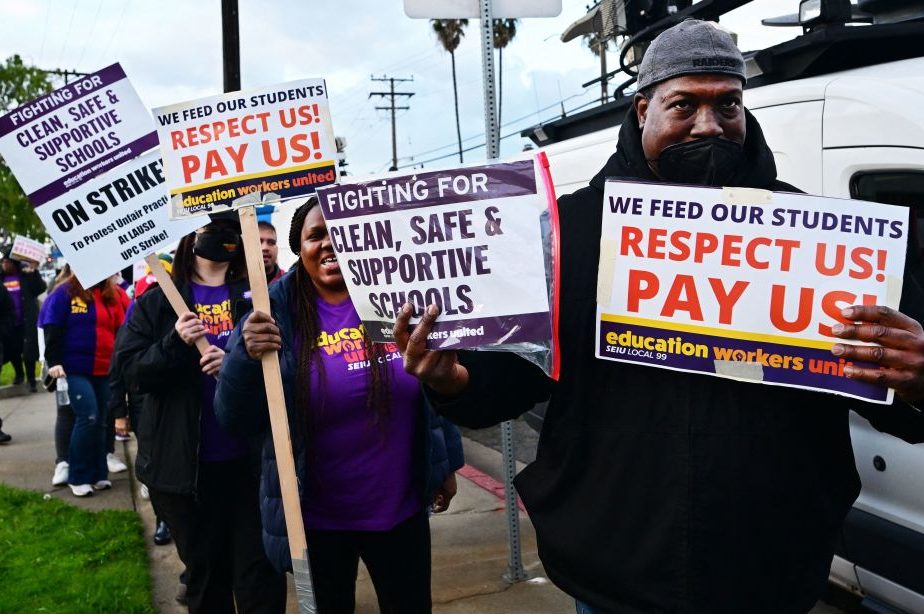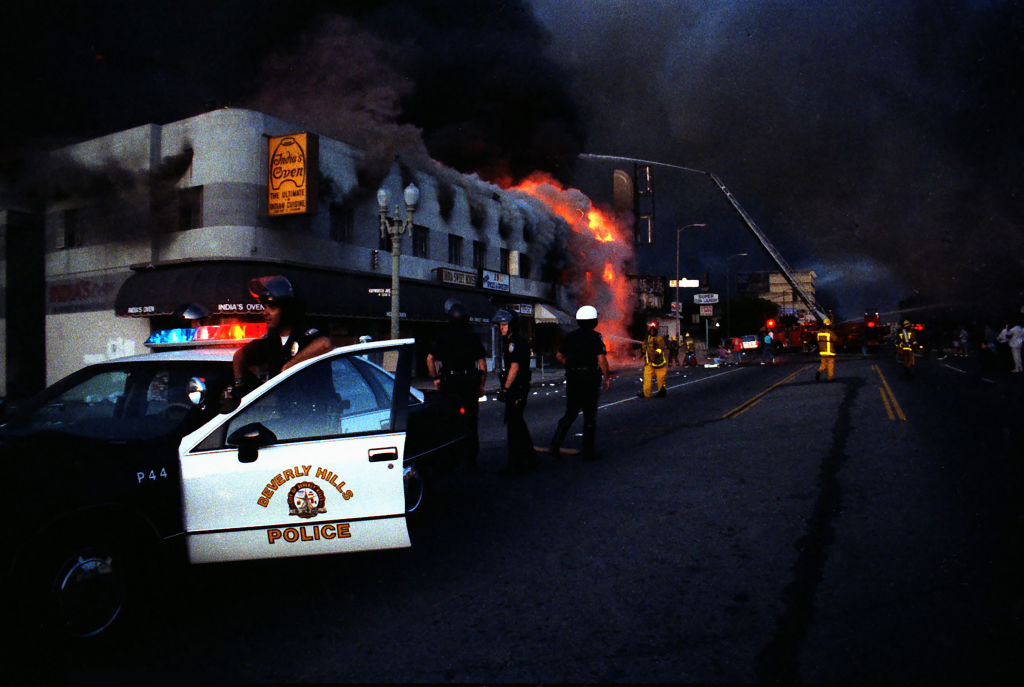Service Employees International Union Local 99 staged a three-day walkout in Los Angeles last week after negotiations failed. SEIU, which represents about 30,000 cafeteria workers, bus drivers, special education assistants, etc. called for a strike if their demands were not met by the Los Angeles Unified School District. And the United Teachers of Los Angeles decided to ditch school, too, in what was deemed a “sympathy strike.” The unions’ action forced every public school in LA to shut down from March 21 to March 23.
It all played out in the usual way. The unions huffed and puffed, accused management of withholding a rightful pay increase, told lies and half-truths, kids’ education was disrupted, and media complicity was bountiful, while the LAUSD superintendent asserted that the district could not afford to accede to the unions’ demands.
The rhetoric was straight from the Unionese handbook. “These are the co-workers that are the lowest-paid workers in our schools and we cannot stand idly by as we consistently see them disrespected and mistreated by this district,” UTLA president Cecily Myart-Cruz insisted during a news conference.
After shutting down for three days, the schools reopened on Friday March 24 — and voila! A deal was reached the same day — and the union wound up getting almost all of what it wanted.
But while school district honchos and unionistas were jubilant, the kids of Los Angeles suffered more damage as pawns in the adult arena. Three days of school were eliminated with no plan in place to make up for the lost time.
“Lost time” is not new for LA; UTLA forced a mass shutdown of LA schools for more than a year during the Covid hysteria — and students were neglected during that time. The union contract stipulates that the professional workday for a full-time, regular employee “requires no fewer than eight hours of on-site and off-site work.” Yet during the shutdown, then-UTLA boss Alex Caputo-Pearl engineered a deal that required teachers to provide instruction and student support for just four hours per day — and also to “host three office hours for students” every week. So instead of a forty-hour work week, teachers in LA only had to be available for twenty-three hours. Additionally, teachers could create their own work schedules “and were not required to teach classes using live video conferencing platforms.”
When asked about the learning loss that students incurred during the shutdown, UTLA president Cecily Myart-Cruz spat out, “There is no such thing as learning loss. Our kids didn’t lose anything. It’s OK that our babies may not have learned all their times tables. They learned resilience. They learned survival. They learned critical-thinking skills. They know the difference between a riot and a protest. They know the words insurrection and coup.” She even went so far as to suggest that “learning loss” is a fake crisis marketed by shadowy purveyors of clinical and classroom assessments.
No, the crisis in LA is quite real. Scores were down considerably on the post-shutdown 2022 state standardized tests. At this juncture, 40 percent of sixth-graders and 43 percent of seventh-graders meet grade-level standards in English. And just 19 percent of seventh-graders and 23 percent of eight-graders are at grade level proficiency in math.
As we have seen time and again, the students aren’t exactly a priority for the teachers’ unions. Accurate reporting of education worker earnings is also not a concern to much of the media. While there was much sympathy garnered by many during the strike for the “overworked and underpaid” workers, a look at the facts tells a very different story.
For starters, with all the whining about low salaries, education workers’ non-salary perks were not up for discussion in the MSM — notably, the defined benefit (403b) pension plans. While education workers’ pensions are funded to some extent by the workers themselves, the bulk of the payment is supplied by the school district — and therefore the taxpayer — and the local and state government — also the taxpayer. It’s a “defined benefit” set-up whereby the teacher, upon retiring, receives a fixed monthly amount for life… no matter how much he or she has actually contributed to the plan.
Also, as revealed by Transparent California, there are several other ways education workers add to their base pay like overtime and generous health care plans. A special education trainee is typical. His base pay is $36,775, but when all the various perks are added in, his pay in 2021 was $72,121.
Representative Adam Schiff, the Senate candidate who joined workers at a pre-strike rally Tuesday, claimed that the service workers should not be earning poverty wages. “The median income of our bus drivers and our cafeteria workers and our school aides is $25,000 a year. Who can live on $25,000 a year? Those are poverty wages.”
Schiff and others who made this claim omit the fact that those who make that salary are part-time workers.
It also bears mentioning that, as California Policy Center’s Ed Ring notes, perpetual wage increases “that keep up with California’s exploding cost-of-living is, in fact, one of the engines driving inflation: every time a government worker receives an increase, taxes rise — taxes for everyone, including teachers, service workers and families of students in the district.”
The recent bargaining/strike activity is just a warm-up for things to come. UTLA is currently working without a contract, and its leaders monitored the strike theatrics closely. The fact that SEIU members did so well bodes well for the teachers’ union.
No one understands this more than Cecily Myart-Cruz. Stating support for the striking workers, the UTLA boss explained, “This is our opportunity to demonstrate that collective power in a way that will impact our relationship with the district for the Beyond Recovery contract demands this school year, and the future of public education. Let’s remember that we are fighting for a 20 percent salary increase, lower class sizes, more school nurses, teacher librarians, counselors, psychiatric social workers, pupil services, attendance counselors, school psychologists, fully funded special education, the Black Student Achievement Plan, expanded community schools, expanded green spaces and a plan for clean and healthy schools.”
The school board and SEIU rank and file still must ratify the new contract, but it is a done deal. The workers made out like bandits, and as Caputo-Pearl wrote on his union’s blog a few years back, “The school board is our boss. We have a unique power — we elect our bosses. It would be difficult to think of workers anywhere else who elect their bosses. We do. We must take advantage of it.”
It should be painfully obvious that public schools in Los Angeles are totally beholden to the teachers’ union. No one should be surprised that LA Unified schools were home to 737,000 students twenty years ago, but now the district has dwindled to 430,000, and things are looking bleak for the nation’s second largest school district.
Clearly, with a great assist from the teachers’ union, LAUSD has struck out.

























